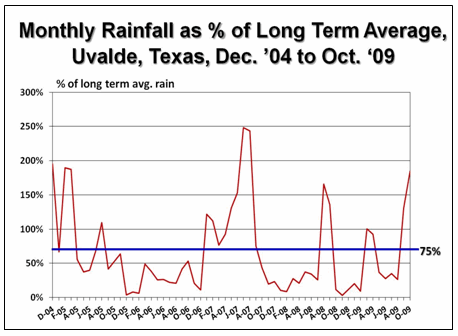Vol. 25, Issue 35, October 28, 2009 – PDF version
Jose G. Peña, Texas AgriLife Extension Economist-Management
Rainfall during September-October 26, 2009 in Southwest Texas ended at close to twice the long term average. The rain has helped green-up the region, improve forage availability, filled dry stock tanks, made possible small grain planting, reduced livestock supplemental feeding requirements and provided an excellent boost to small grains, peanuts, pecans and winter vegetable crops which are making good progress.
While the rain improved the agricultural situation and is providing some hope after an extended severe drought, the Southwest Texas region remains in a drought situation. As measured in Uvalde, Texas, which probably reflects the moisture situation in a large portion of Texas, especially the South Central and Southwest region, year-to-date cumulative rainfall remains at less than 70 percent of the long term average.
Farming operations are expected to recover, but it will take years for pastures and ranges to recover from this recent severe drought, which has lasted close to five years in Southwest Texas, since January 2005. Some ranges may not recover without major renovation. Livestock restocking may have to be delayed until pastures and ranges show signs of recovery.
The Southwest Texas region entered into drought conditions (75% of average long term rainfall) in early 2005 and has remained in severe drought conditions through October 2009. (See Figure 1) The last 58-month period from January ’05-to-October 26, 2009, was the driest period on record, with total cumulative rainfall at about 66 percent of the long term average. This drought period has been more severe than the commonly referred “drought of record of the ‘50’s.”
Monthly rainfall during that 58-month period averaged 1.35 inches (including September-October ’09), compared to a long term monthly average of 2.01 inches. That is about 33 percent less rainfall than the average amount which created the ecological environment which evolved from that long term rain.
The forage situation has improved, but forage availability will remain in relatively short supply as temperatures decline and growth terminates with the first fall killing frost. Even as the rainfall outlook improves as the region transitions from La Niña (favors drought in the southern U.S. tier) to the El Niño phenomena (favors more rain in the southern U.S. tier), it appears doubtful that sufficient forage will be produced to allow livestock re-stocking soon. Even with minimum livestock stocking rates, degradation of the forage production situation, as a result of the extended drought, will continue to have serious implication to the agricultural production situation in Southwest Texas. Wildlife population densities are down significantly. The currently improved forage situation may provide better nutrition to remaining wildlife and may mean an improved wildlife crop next spring. Wildlife resource management for profit has become the economic lifeline for many ranching operations.
Permanent Change to the Eco System?
The current extended drought caused long-term degradation to the eco-system, especially to ranges which had been overgrazed. In the final analysis, the real effect of any drought is its influence on vegetation and the vegetation’s capability to recover. To recover, the vegetation’s seed or rootstock must survive a drought. Seed/rootstock must be protected during periods of reduced rainfall, such as severely reducing grazing pressure. In addition to the abundant timely rainfall of September and October, recovery of overgrazed ranges will require continued reduced stocking rates and continued above average rainfall. This appears unlikely. Even with the improved rainfall forecast, it may be difficult to recover.
In addition, while ranchers were making major range improvement investments through the early 90’s, these activities appear to have been reduced significantly. As a result, it appears that the eco-system in a large portion of Southwest Texas will be significantly altered and become more economically dependent on wildlife management.
Appreciation is expressed to Dr. Hagen Lippke for his contribution to and review of this article.

